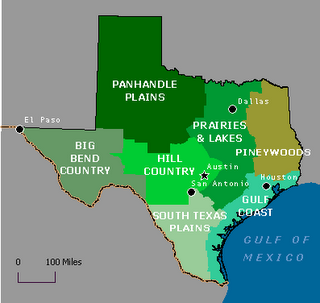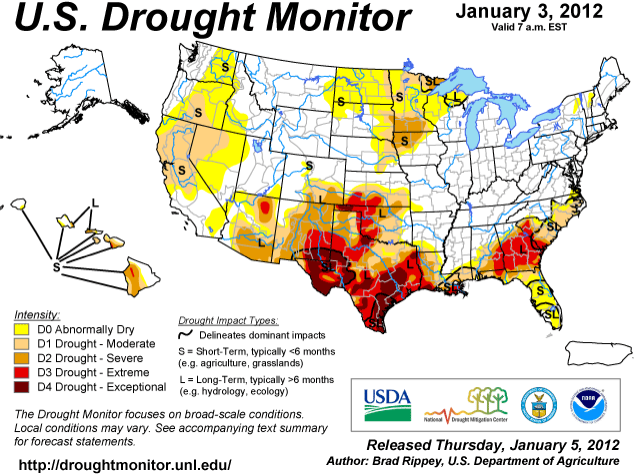Texas 2011 Drought, $93 Billion in Tree Losses?
Reprinted with permission from Chris Searles‘ blogspot
“Nobody knows the true economic value of trees.” That’s the first thing that popped into my head last week when I read the Texas Forest Service recently estimated up to a half billion Texas trees measuring at least five inches in diameter were lost due to the unrelenting drought of 2011.

I already knew the state had lost close to four million acres of open lands to record wildfires, suffered over five billion dollars in agricultural and livestock damages, considered shutting down parts of its electric grid to prevent rolling blackouts due to water shortages, and that the list goes on. I also knew the long-term effects of Texas’s drought looked equally dismal and that all its damage didn’t just hurt Texans, but seriously? Hundreds of million of trees “killed?” That sounds expensive.
The economic value of trees. I did a little digging. It doesn’t take much time on Google to figure out the average value of an urban tree is about $1,000.00 per tree. The range of valuations, however, is huge. I have a friend who recently paid $7,500 to have three trees “installed” in his yard. The Council of Tree and Landscape Appraisers says, “A mature tree can have an appraised value of between $1,000 and $10,000.” A US Court once valued a single, mature tree at over $160,000.00. But let’s go with the City of Arlington, TX’s 2009 study (pdf), which appraises their urban trees at about $932.50 per tree. Since the Arlington study omits many of the intrinsic services associated with both wild and urban trees in their valuation and since Arlington’s number is the lowest I could find, let’s assume this is a fair and conservative tree value and use it. Multiple the number of trees lost times the Arlington valuation, and you get:
-$93,250,320,404.72. -$93.2 Billion (in 2009 dollars). That’s Arlington’s $932.50 per tree x 100 Million tree losses. But wait, that’s the low number. Texas Forest Service estimates “between 100 million and 500 million” trees died last year. Their high end count of nearly half a billion trees nets out a total impact of over -$466 Billion ($466,251,602,023.61 to be exact). Impressive, right? People seem to have a hard time thinking of the environment as having any economic value, perhaps that’s because the environment’s value dwarfs our little human-made economy. I’ve always suspected the “dollar” value of ecosystem services to be many orders of magnitude greater than the entire industrialized economy. How couldn’t it be? How could Texas suffer around $100 Billion in ecosystem losses during a recession year and not be severely impaired? And what is the industrial economy is catching up? Perhaps events like this massive tree die off are whittling down our natural systems and there are only a few orders magnitude of greatness left in our nature. Texas Forest Service estimates from 2% to 10% of the state’s 4.9 billion trees were just killed.* How many consecutive years can Texas sustain around $100 Billion in forest destruction? 49 years? 9 years? The drought is expected to continue for at least five years. If that comes to pass, its effects will likely have significantly changed much of Texas as early as 2017. Climate aficionados like me believe Austin will become more like Tucson over the next 90 years as desertification moves north. But what if that transition has already begun? What if Austin’s desertification will be securely in place sometime in the next 10 years? What’s Austin without trees? What happens to Austin’s water cycle and summertime temperatures? Plenty of climate scientists believe Texas is indeed on a super rapid change trajectory, way ahead of schedule.
How Texas compares to the rest of the country
But nobody knows the economic value of trees. Or ecology. Or nature itself. And that’s the point. Our environment should probably contain exponentially more economic value than our industrial economy. Perhaps we should start counting. And start changing. If you believe, as I tend to, that we humans are playing Russian roulette with the planet’s future, changing the way society measures economic success is paramount, as is eliminating the emissions believed to be driving things like radical drought, as is preserving our trees and ecosystems.
Resources
- Tree Services. Trees perform so many services.The Texas Trees Foundation lists the popularly accepted ones, such as: energy efficiency, human health benefits, pollution control, and property value enhancement. Trees Are Good, big fans of trees, list several more. The Municipal Research and Services Center of Washington has an even longer list including intangibles, such as psycho-social dimensions and positive effects on consumers in shopping malls. iTree is an industry-embraced software, being used around the world, to appraise trees according to a number of different criteria.
- Lake Levels are another indication of total precipitation in the system. Texas lakes are generally speaking at all time lows. Check out the USGS and LCRA measurements.
- Fruit Trees. Texas has (had?) an abundant food production economy, particularly in the southern regions of the state, thanks to grapefruit, lime, etc. Learn more here.
- Tree Calculator. Calculate the value of your own trees here.
- Photo Gallery. View one local drought photo gallery here.
*Total value of 4.9 Billion Texas trees, at $932.50 per tree in 2009 dollars is 4,589,250,000,000 ($4.5 Trillion).
